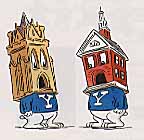| |
Comment on this article
Yale’s Tallest Tales
Institutions laden with traditions often develop some that are pure hooey. Yale has lots.
March 1998
by Mark Alden Branch ’86
Each Member brought a Number of Books and presented them to the Body; and laying them on the Table, said these Words, or to this effect: “I give these Books for the founding of a College in this Colony.”
It is Yale’s version of the book of Genesis, the founding story that has moved generations of alumni to match the generosity of the ten ministers who met in Samuel Russel’s parsonage in Branford to part with their most prized possessions, the legendary “40 folios.”
| |

|
The only trouble is that it probably never happened, at least not the way 18th-century Yale President Thomas Clap described it above. The late Yale historian George Wilson Pierson '26 devoted an entire book to Clap’s story, concluding that, while it had elements of truth (some of the ministers did give books before and after the founding), Clap had engineered the tale to score a legal point. Embroiled in a dispute with the Connecticut General Assembly over control of the College in 1766, Clap sought to show that the College had been founded privately before it received its charter from the colony. The ploy worked, and the story endured for more than 200 years. It is depicted in wood and stone in the Branford Chapel and Sterling Memorial Library, and is even the origin of the name of Branford College. It is, in short, the mother of Yale’s tall tales.
While we know the source of the “40 folios” story, there are a number of other Yale tales whose veracity is no less dubious, but whose origins are a bit cloudier. Many of these stories find their way into the daily campus tours led by undergraduates. (The more responsible guides are careful to label them as legends.) But while Clap sought to aggrandize Yale, these contemporary yarns aims to humanize the place. Like Greek myths, which showed their gods to be as fallible as mere humans, Yale’s tall tales are filled with half-mad donors, avaricious administrators, and remarkably incompetent builders. What follows are a few of the stories that have made the circuit in recent years—and, where possible, the truth behind them.

The College With Two Faces
When the University expanded across York Street to build two new residential colleges in 1930, architect James Gamble Rogers decided that red-brick Georgian architecture would be more appropriate to the scale of the neighborhood than the previously favored Gothic. (The Georgian style also happened to be cheaper to build.) But since one of the two, Davenport College, would face York Street, where Rogers had already orchestrated a Gothic streetscape for Branford and Saybrook, he dressed that façade in sandstone and gave it Gothic details.
| |

|
A straightforward enough story—too straightforward to make a really good saga, so Yale mythmakers have created family dramas worthy of Aeschylus to explain the dichotomy. One tale has it that Mrs. Stephen Harkness funded Harkness Tower with the provision that everything built within view of its top must be of the Gothic style, resulting in the York Street coverup. (One problem: The interior of Davenport is plainly visible from Harkness.) An explanation with Oedipal overtones posits that James Gamble Rogers died during construction, and that his son, taking over the job, promptly overthrew his father’s beloved Gothic. (But Rogers lived until 1947, well after the college was completed.) A version that combines both stories has a Gothic-hating Edward Harkness bucking his mother’s wishes after her death.

Knaves of the Cathedral
Why does Yale have a Gothic gymnasium? You could easily say “Why not?” but that would leave the University a fable poorer. One myth holds that Mrs. Payne Whitney wanted Yale to build a great cathedral with her money, but that the University preferred a gym. Since she was getting old, the story goes, administrators thought they could get away with a bit of subterfuge. They instructed architect John Russell Pope to design a gym that could pass for a cathedral. Then, when it was completed, the President drove Mrs. Whitney past the finished building. She died not long after, content in the knowledge that she had given Yale such a grand house of worship—and not what came to be known as “the cathedral of sweat.”

The Incredible Disappearing Library
| |

|
It was originally to have been made of green onyx to celebrate the fortune the donor made in S&H Green Stamps. Its sophisticated fire-prevention system automatically sucks all the oxygen out of the book stacks in case of fire, sacrificing any library personnel unlucky enough to be inside. And best of all, the whole building can be lowered deep into the ground to protect it from a nuclear holocaust. The Beinecke Rare Book and Manuscript Library is customarily the last stop on the official Yale tour, so the guides have clearly worked hard to come up with a kicker for departing guests. For the record, the Beineckes did own S&H Green Stamps, but the marble was never intended to be green. The original fire-prevention system—which has since been replaced—was designed to flood the stacks with carbon dioxide, but it was to be activated only after the area was evacuated. Curator Christa Sammons (who claims to have originated the green marble story) says that sinking the building into the ground wouldn’t work so well: The high water table below the building would leave the books unscorched, but soaked.

The Man Who Loved Vanderbilt
Legends tend to rise—and evolve—-concerning stops along the prescribed route that tour guides follow. Fifteen years ago, tourists were often told that Vanderbilt Hall’s courtyard faced the “wrong” way (toward Chapel Street) because the builders had poured the foundations while reading the plans upside down. The opulent “Vanderbilt suite” above the archway—reserved for members of the Vanderbilt family when attending Yale—was mentioned in passing. These days, the upside-down plans story has been discarded (it was apparently too much even for tourists) in favor of the purely fictional tale of how, after many years, a Vanderbilt scion claimed his right to live in the suite—in the same year the building was designated as housing for Yale’s first female undergraduates. The story has it that the young man threatened to sue before Yale agreed to let him live there, and that the happy result was that he met his future wife in Vanderbilt Hall.

Foot Fetish
One of the most striking testaments to the mythmaking powers of tour guides is Theodore Dwight Woolsey’s toe. Some time in the last ten years, someone invented a “tradition” of rubbing the toe of the Woolsey statue on the Old Campus for luck, explaining that students employ this practice before exams. Similar traditions exist at many other institutions, but it’s difficult to find an alumnus over the age of 30 who has ever heard about President Woolsey’s toe. Nevertheless, tour guides spread the story diligently, inviting visitors to give it a try themselves. As a result, the statue, the rest of which is a dull gray-green, has a left toe that has been rubbed shiny, and the story seems for all practical purposes as old as the statue itself.

Watch Your Step
Like the Woolsey statue, the millstone embedded in the sidewalk in the Branford College courtyard near Harkness
Tower has fairly recently become the subject of a superstition. It is said that if an undergraduate steps on the millstone, he or she will never graduate. (A similar legend exists about walking through the nearby Memorial Gate.) The reasons for this curse are sketchy, although one version has it that a construction worker fell from Harkness Tower to his death on that spot. More creative was the tour guide who told a true story about how, in 1718, the people of Saybrook had sabotaged the ox-carts that were to transfer the Yale library to New Haven. “And that,” the guide added, pointing dramatically at what is unmistakably a millstone, “is a wheel from one of those ox-carts.”  |
|






